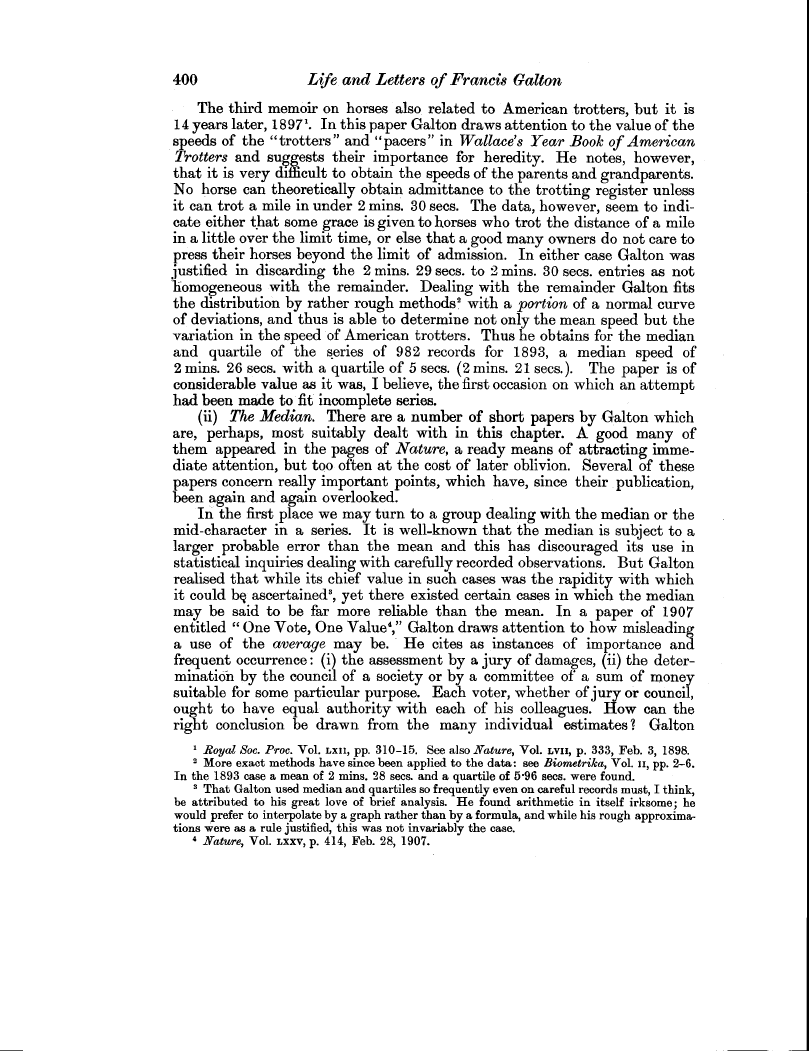400 Life and Letters of Francis Galton
The third memoir on horses also related to American trotters, but it is 14 years later, 18971. In this paper Galton draws attention to the value of the speeds of the "trotters" and "pacers" in Wallace's Year Book of American Trotters and suggests their importance for heredity. He notes, however, that it is very difficult to obtain the speeds of the parents and grandparents. No horse can theoretically obtain admittance to the trotting register unless it can trot a mile in under 2 mins. 30 sets. The data, however, seem to indicate either that some grace is given to horses who trot the distance of a mile in a little over the limit time, or else that a good many owners do not care to press their horses beyond the limit of admission. In either case Galton was justified in discarding the 2 mins. 29 sees. to 2 mins. 30 sees. entries as not 'homogeneous with the remainder. Dealing with the remainder Galton fits the distribution by rather rough methods2 with a portion of a normal curve of deviations, and thus is able to determine not only the mean speed but the variation in the speed of American trotters. Thus he obtains for the median and quartile of the series of 982 records for 1893, a median speed of 2 mins. 26 sees. with a quartile of 5 sees. (2 mins. 21 sees.). The paper is of considerable value as it was, I believe, the first occasion on which an attempt had been made to fit incomplete series.
(ii) The Median. There are a number of short papers by Galton which are, perhaps, most suitably dealt with in this chapter. A good many of them appeared in the pages of Nature, a ready means of attracting immediate attention, but too often at the cost of later oblivion. Several of these papers concern really important points, which have, since their publication, been again and again overlooked.
In the first place we may turn to a group dealing with the median or the mid-character in a series. It is well-known that the median is subject to a larger probable error than the mean and this has discouraged its use in statistical inquiries dealing with carefully recorded observations. But Galton realised that while its chief value in such cases was the rapidity with which it could be ascertained', yet there existed certain cases in which the median may be said to be far more reliable than the mean. In a paper of 1907 entitled " One Vote, One Value4," Galton draws attention to how misleading a use of the average may be. He cites as instances of importance and frequent occurrence : (i) the assessment by a jury of damages, (ii) the determination by the council of a society or by a committee of a sum of money suitable for some particular purpose. Each voter, whether of jury or council, ought to have equal authority with each of his colleagues. How can the right conclusion be drawn from the many individual estimates? Galton
' Royal Soc. Proc. Vol. LXII, pp. 310-15. See also Nature, Vol. Lvii, p. 333, Feb. 3, 1898.
2 More exact methods have since been applied to the data: see Biometrika, Vol. ii, pp. 2-6. In the 1893 case a mean of 2 mins. 28 sees. and a quartile of 5.96 sees. were found.
s That Galton used median and quartiles so frequently even on careful records must, I think, be attributed to his great love of brief analysis. He found arithmetic in itself irksome; he would prefer to interpolate by a graph rather than by a formula, and while his rough approximations were as a rule justified, this was not invariably the case.
4 Nature, Vol. LXXV, p. 414, Feb. 28, 1907.

